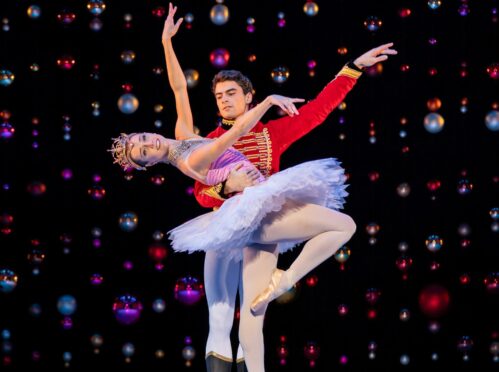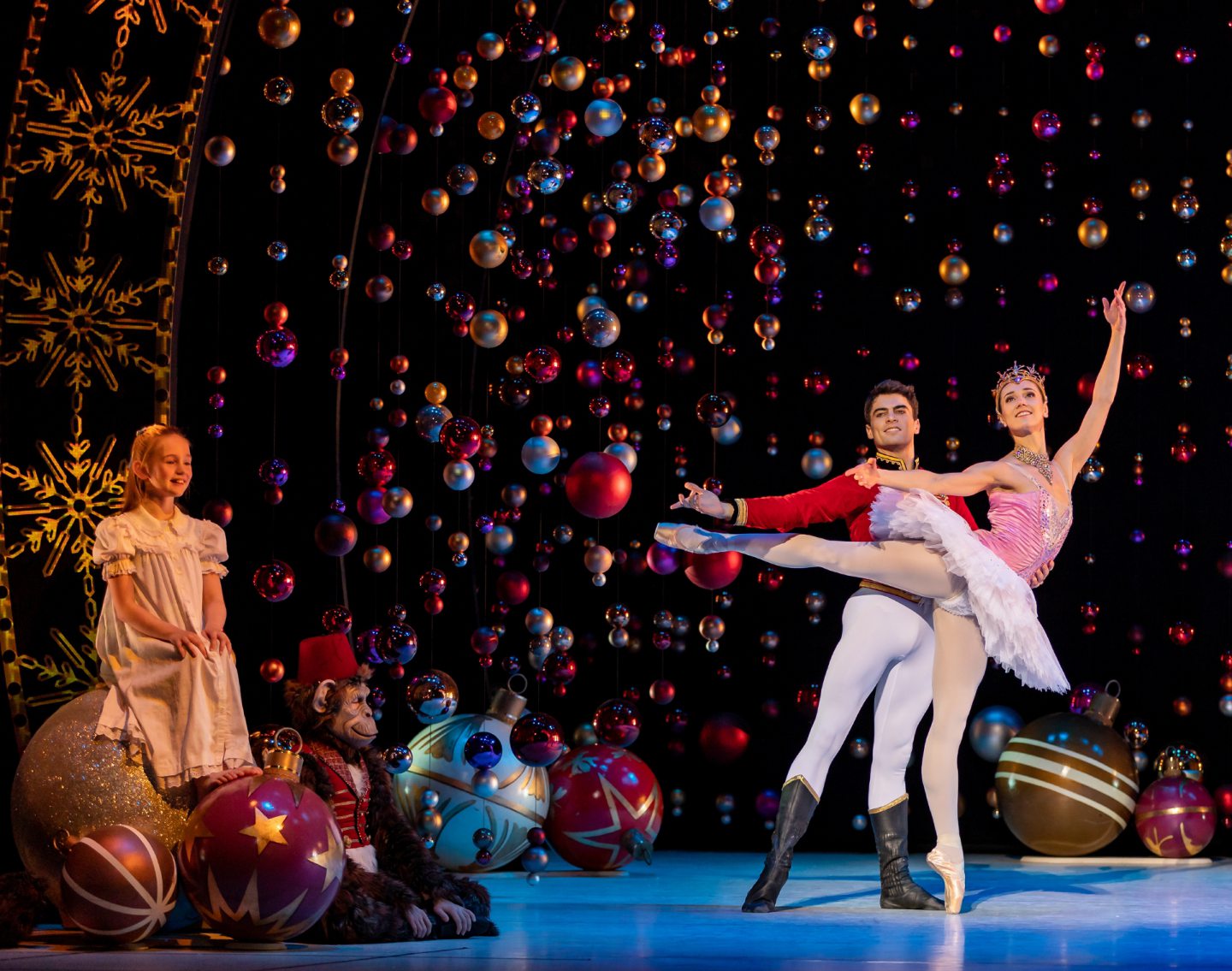
With sumptuous scenes of a snowy winter, a cast of colourful characters, and a dazzling dance performed to a stirring score, it is little wonder that The Nutcracker has become a Christmas tradition for so many.
Much like panto is a guaranteed seller for theatres, The Nutcracker is a sure thing for ballet, and this year, a much-needed boost for audiences and dance companies alike.
Scottish Ballet has turned to the 129-year-old production to mark the company’s return to the festive live stage, performing in Edinburgh from now until Hogmanay, before extending the season of goodwill by touring to Glasgow, Inverness, Aberdeen, Newcastle and Belfast in the New Year, giving 74 performances in total.
For Scottish Ballet’s CEO and artistic director, Christopher Hampson, the secret to its enduring appeal lies in the way it connects generations of audiences.
“The Nutcracker has a special place in ballet history but also a special place in Scotland, in particular, because we do the production that our founder Peter Darrell created,” he explained.
“We get stories from audience members who were taken to see it as a child, or were even in it in some cases, and it is a really good connector, as it is so family friendly and that is part of its appeal.
“As far as a sure thing, it’s up there with something like Swan Lake. Most people you ask would know Swan Lake means ballet, it means graceful dancers, and when you say Nutcracker, people can hum a tune and they know the silhouette of the story – it’s within our consciousness.
“We know it means Christmas, family entertainment and magic. I hear so many audience members walking out at the end, saying how Christmassy they now feel, so it can be the start of Christmas but it goes beyond that, too. We notice people will buy tickets for loved ones as a Christmas present, so they often come afterwards, too.”
The Nutcracker had an inauspicious start, receiving bad reviews when it premiered in St Petersburg in 1892.
“It was put to bed quickly and was only revived once,” Hampson continued.
“It wasn’t until the 1950s, when Alicia Markova in the UK and George Balanchine in America, created productions at Christmas that it revived interest in the score and story, and since then it’s become a real tradition. For a lot of people, it’s the first ballet they see, and I think the Christmas link allows it be revived so often.

“So, it has become a tradition but it didn’t start out that way. I’ve always thought because it was a flop in its first iteration, in a way it allowed for so many different interpretations, because everyone was trying to crack the nut, if you like, to get the production right.
“Everything we bring back we always take a fresh look at and The Nutcracker is no exception. I felt we could do better at representing some of the countries that are in act two’s dance, because it felt like a bit of a caricature in terms of representation.
“Also, the central hero, Drosselmeyer, who makes all the magic happen, will be played some nights by a male dancer, some nights by a female dancer. We wanted to reaffirm that heroes can be men or women.”
Principal dancer Evan Loudon, who plays the Nutcracker Prince, said: “This is my third time performing the role, but it still has that same special feeling it did the first time.
The grand pas de deux in act two is such an iconic one to do with the Sugar Plum Fairy.
And in the Scottish Ballet version, we’re on for most of act one and do a grand pas de deux with the Snow Queen and snowflakes, which is quite different and full on. It’s challenging for stamina and for partnering, but I love the challenge and I love my Snow Queen and Sugar Plum Fairy I’m working with.”
Fellow principal dancer Marge Hendrick said: “This is my first time playing the Sugar Plum Fairy and it’s quite a challenge.
“The Nutcracker is iconic and everyone knows the music. I’d always seen the role performed by shorter dancers and I’m tall, so I’m enjoying it and I’m really glad it has been made available to me.”
There are a number of Nutcracker productions in the UK this Christmas, with four in London in one week, but Hampson – who has had a connection to the show since he was eight years old – says it’s a case of the more the merrier.
“I don’t think there will come a point of over-saturation. The more stories we tell, the more compelling they are, the more choices people have.
“I was eight when I was in my first production and it’s been in my life every year since – whether I’ve been dancing, choreographing, directing, reproducing or coaching dancers.
“I’m 48 now, so it’s been 40 years. I still find new things and I still love it. Upon hearing that first note of the overture, I always get that fizz of excitement, because it brings back so many different memories.”
The Nutcracker, Festival Theatre, Edinburgh, until December 31, then on tour
The Principles
Marge Hendrick, from Paris, and Evan Loudon, from Sydney, joined Scottish Ballet within six months of each other in 2012 and 2013, and were put together as dance partners soon after.
They were each promoted to principal dancer shortly before lockdown struck
in March 2020.
Loudon said: “We were put together for our heights, but then realised we danced really well together, and we’ve grown as partners and people over the years, and know each other’s body so well now.”
He started in gymnastics at five, and his coach suggested he try dance because he was so good at floor work.
“I fell in love with ballet and everything escalated quickly. I entered the McDonald’s Ballet Scholarship at Sydney Opera House and won the boys’ scholarship, and that helped me get funding to go to ballet school. To dance on the Opera House stage was phenomenal, especially being from the city.”
Shortly after being made principal, Hendrick travelled to America on an exchange programme to perform with Ballet West.
“It was an amazing experience and boosted my confidence, and I felt legitimate being there. I came back just before lockdown,” she said.
Loudon and Hendrick agree that lockdown, in the beginning, was beneficial for them to recuperate their minds and bodies, but they were soon eager to get back on stage.
“I’ve been practising Pilates for years, so I decided to take a course to become a teacher during lockdown and I qualified last year,” said Hendrick. “Scottish Ballet also had classes organised on Zoom and we had a dance floor delivered to our homes, but it feels great to be back in front of a live audience again.”
Loudon added: “It was good to have that rest, but it also made me realise how much I want to do this job.
“We did classes over Zoom, which is fun to a point, but you don’t want to knock over a table or have the downstairs neighbour complaining when you start to jump, so it was great to get back into the studio.”
The Children
While many companies use an adult dancer in the role of Clara, the young girl who discovers the magical world of the Nutcracker Prince and Sugar Plum Fairy, Scottish Ballet cast children for the part, and others, such as her brother Fritz.
“It’s great working with the kids and they add a little bit of festiveness to the show – you see how excited they still are deep into the tour and that gives us a little something, too,” said Evan Loudon, who plays The Nutcracker Prince.
“They’re really cute and it’s fun to see them looking up and really admiring each dancer,” explained Marge Hendrick, who is the Sugar Plum Fairy.
“At every venue we have a different group of kids. We also have a lot of kids in the audience, which is priceless. A lot of them come wearing their tutus and it’s very festive and a lot of fun.”
Twelve-year-old Chloe Macduff is one of five young dancers playing Clara.
She said: “I went to see The Nutcracker when I was seven with my granny and my wee sister. I really loved it and dreamed I would dance on the stage one day.
“The Nutcracker is so colourful and full of joy, especially the party scene, because I love the costumes and seeing everyone dance together. I’m so excited to perform with Scottish Ballet and can’t wait to meet the Sugar Plum Fairy.”

Enjoy the convenience of having The Sunday Post delivered as a digital ePaper straight to your smartphone, tablet or computer.
Subscribe for only £5.49 a month and enjoy all the benefits of the printed paper as a digital replica.
Subscribe